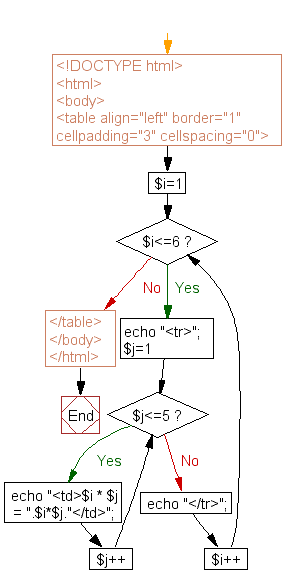PHP for loop Exercises : Create a table with text in columns using for loops
PHP for loop: Exercise-8 with Solution
Write a PHP script that creates the following table using for loops. Add cellpadding="3px" and cellspacing="0px" to the table tag.
Sample Solution:
PHP Code:<!DOCTYPE html>
<html>
<body>
<table align="left" border="1" cellpadding="3" cellspacing="0">
<?php
for($i=1;$i<=6;$i++)
{
echo "<tr>";
for ($j=1;$j<=5;$j++)
{
echo "<td>$i * $j = ".$i*$j."</td>";
}
echo "</tr>";
}
?>
</table>
</body>
</html>
Sample Output:
| 1 * 1 = 1 | 1 * 2 = 2 | 1 * 3 = 3 | 1 * 4 = 4 | 1 * 5 = 5 |
| 2 * 1 = 2 | 2 * 2 = 4 | 2 * 3 = 6 | 2 * 4 = 8 | 2 * 5 = 10 |
| 3 * 1 = 3 | 3 * 2 = 6 | 3 * 3 = 9 | 3 * 4 = 12 | 3 * 5 = 15 |
| 4 * 1 = 4 | 4 * 2 = 8 | 4 * 3 = 12 | 4 * 4 = 16 | 4 * 5 = 20 |
| 5 * 1 = 5 | 5 * 2 = 10 | 5 * 3 = 15 | 5 * 4 = 20 | 5 * 5 = 25 |
| 6 * 1 = 6 | 6 * 2 = 12 | 6 * 3 = 18 | 6 * 4 = 24 | 6 * 5 = 30 |
View the output in the browser
Flowchart:

Have another way to solve this solution? Contribute your code (and comments) through Disqus.
Previous: Write a program which will count the "r" characters in the text "w3resource".
Next: Write a PHP script using nested for loop that creates a chess board as shown below.
What is the difficulty level of this exercise?
Test your Programming skills with w3resource's quiz.
PHP: Tips of the Day
How to Sort Multi-dimensional Array by Value?
Try a usort, If you are still on PHP 5.2 or earlier, you'll have to define a sorting function first:
Example:
function sortByOrder($a, $b) {
return $a['order'] - $b['order'];
}
usort($myArray, 'sortByOrder');
Starting in PHP 5.3, you can use an anonymous function:
usort($myArray, function($a, $b) {
return $a['order'] - $b['order'];
});
And finally with PHP 7 you can use the spaceship operator:
usort($myArray, function($a, $b) {
return $a['order'] <=> $b['order'];
});
To extend this to multi-dimensional sorting, reference the second/third sorting elements if the first is zero - best explained below. You can also use this for sorting on sub-elements.
usort($myArray, function($a, $b) {
$retval = $a['order'] <=> $b['order'];
if ($retval == 0) {
$retval = $a['suborder'] <=> $b['suborder'];
if ($retval == 0) {
$retval = $a['details']['subsuborder'] <=> $b['details']['subsuborder'];
}
}
return $retval;
});
If you need to retain key associations, use uasort() - see comparison of array sorting functions in the manual
Ref : https://bit.ly/3i77vCC
- New Content published on w3resource:
- HTML-CSS Practical: Exercises, Practice, Solution
- Java Regular Expression: Exercises, Practice, Solution
- Scala Programming Exercises, Practice, Solution
- Python Itertools exercises
- Python Numpy exercises
- Python GeoPy Package exercises
- Python Pandas exercises
- Python nltk exercises
- Python BeautifulSoup exercises
- Form Template
- Composer - PHP Package Manager
- PHPUnit - PHP Testing
- Laravel - PHP Framework
- Angular - JavaScript Framework
- Vue - JavaScript Framework
- Jest - JavaScript Testing Framework
